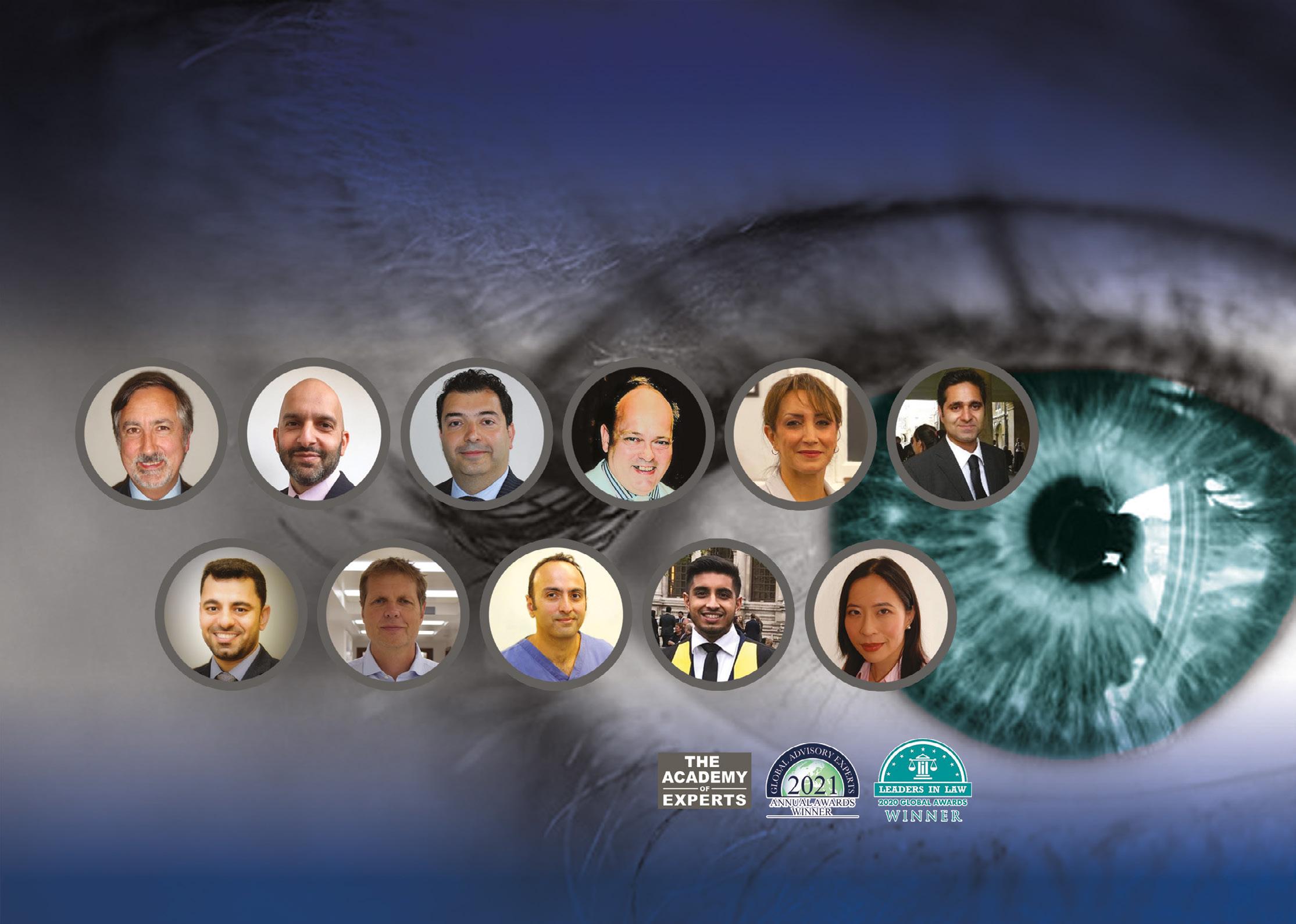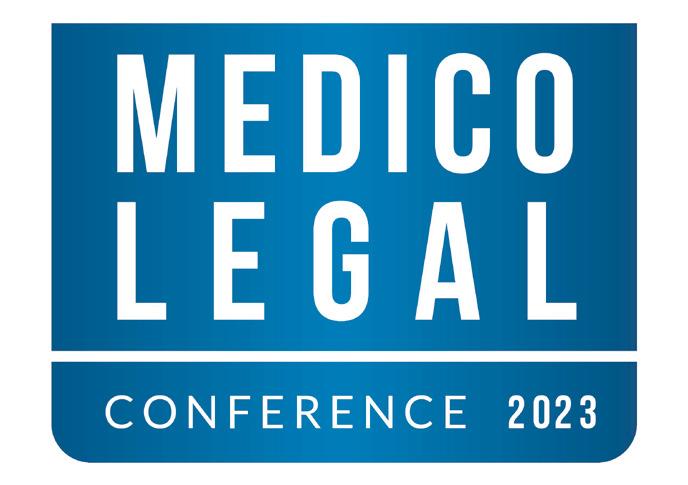LEGAL MEDICO

Presented by:














Welcome to Issue 21 of the Medico-Legal Magazine, produced by SpecialistInfo and publishing partner Iconic Media Solutions Ltd.
This final issue of 2022 includes articles from: Nicole Xashimba, Case Worker, MPS, dis cusses the dangers of not being prepared for anaphylaxis; and
Colin H olburn, Consultant in E mergency Medicine, shares his insight on the role of system factors in clinical negligence cases.
Also in this is sue, Anne Marie O’Mahony, Research Assistant (Law) in University College Cork, discusses the new best practice guidelines on the diagnosis of aortic dissection;
Finally, Ella Da vis, Clinical Negligence an d Person al Injury Barrister, Deka Chambers, summarises the current situation regarding the role of expert witnesses in consent cases.
Once again, the magazine will be circu lated to up to 40,000 people in the industry, including doctors, insurance companies, law firms and medico-legal agencies. It has a dedicated website www.medicolegalmagazine.co.uk and a page on the Medico-Legal Section of the Specialistinfo.com website, where all the back issues can be viewed. Printed copies can be ordered from Iconic Media.
Specialistinfo maintains a database of co ntact details for up to 90,000 UK consultants and GPs, including approximately 11,000 consultants and GPs who undertake medico-legal work. We also provide Medico-Legal courses for expert witnesses and promote the members of the Faculty of Expert Witnesses (the FEW).
We welcome feedback from our readers, so pl ease contact us with any suggestions for areas you would like to see covered in future issues or share your news and experiences with us.
Lisa Cheyne Specialistinfo Medico-Legal Magazine
SpecialistInfo Medico-Legal Courses 2023 By Lisa Cheyne
Medical Protection Society case reportLearnings from a death resulting from anaphylaxis By Nicole Xashimba
04 12
08
New Guidelines on Aortic Dissection Diagnosis: A Cure or a Cause for Defensive Medicine? By Anne Marie O’Mahony
Medical Negligence: Individual Error or System Failure? By Colin Holburn
Medico-Legal News By Lisa Cheyne
Presented by:
Published by:
SpecialistInfo t: +44 (0)1423 727 721 e: magazine@specialistinfo.com www.specialistinfo.com

Iconic Media Solutions t: +44 (0) 20 3693 1940 e: info@iconicmediasolutions.co.uk www.iconicmediasolutions.co.uk

Medico-Legal Magazine is published by Iconic Media Solutions Ltd. Whilst every care has been taken in compiling this publication, and the statements contained herein are believed to be correct, the publishers do not accept any liability or responsibility for inaccuracies or omissions. Reproduction of any part of this publication is strictly forbidden. We do not endorse, nor is Iconic Media Solutions Ltd, nor SpecialistInfo affiliated with any company or organisation listed within.
06 16 21 Front cover: image - Freepik.com / author: snowing





Mr M, a 38-year-old financial adviser, was an existing patient of Dr V, a dermatologist. He had a history of acne keloidalis nuchae. Besides the skin disorder, he was a healthy individual with no known comorbidities or allergies. There was no pre-existing surgical history, or family history of cancer.
The keloids in the occipital region of his scalp were secondary to his existing skin condition, for which he was treated with a combination of antibiotics and topical ointments daily.
Mr M received further treatment in the form of intralesional corticosteroids in January and February 2015 respectively. Mr M had returned for his third treatment at Dr V’s rooms in April 2015. Because the administration of the corticosteroids had proven painful during previous visits, Dr V decided to use local anaesthetic before proceeding on this occasion.
The procedure was explained by Dr V to the patient before commencing. Due to the nature and
presentation of the keloid, the insertion of the needle was difficult. It was asked whether the patient could feel anything, to which he replied that he could not feel any pain but he was not feeling well. The procedure was immediately halted and Mr M was asked once more how he felt. At this point he began to breathe heavily, subsequently becoming unresponsive.
When the procedure was halted, the time noted was 10:12. Mr M was placed into the recovery position while help was called for. Mr M was transported on an emergency trolley to the operating theatre, one floor down from Dr V’s rooms, by Dr V, the hospital matron, an anaesthetist and an ENT surgeon.
At approximately 10:16, Mr M was still unresponsive, with no pulse detected.
He was intubated, a drip inserted and 1ml of adrenalin was administered intravenously. Chest compressions began at about 10:19, followed by defibrillation. Further adrenalin infusions up to 5ml and atropine 1mg were administered intravenously.
Mr M was sadly declared dead by the anaesthetist at about 10:28.
Mr M’s wife sued Dr V, alleging that Dr V was negligent and that this led to Mr M’s untimely death. It was alleged that the cause of death was anaphylaxis due to the anaesthetic used during the procedure. Among other things, it was alleged that Dr V failed to warn Mr M that the local anaesthetic could be fatal. It was further alleged that Dr V failed to obtain informed consent for the procedure.
Dr S, an emergency medicine practitioner, provided the following expert opinion:
Adrenaline is a critical medication in the treatment of anaphylaxis and is found to be ineffective in only 10% of most cases. It appears that there was a significant delay in the administration of intramuscular adrenaline, and delayed administration is often associated with a poor outcome. Adrenaline should have been administered at the earliest possible time, which would have been around 10:13, had the ampoule and other stock (ie needle and syringe) been readily available in Dr V’s rooms.
It was not established exactly when Mr M was noted to be pulseless. This should have been among the first diagnostic tests performed in order to proceed with the correct protocol for the treatment of cardiac arrest, which is to immediately begin chest compressions. As per Dr V’s chronology of events, this commencement of chest compressions had begun in theatre.
Considering that fatality as a result of medicineinduced anaphylaxis is rare and often difficult to predict, it is reasonable to expect a practitioner to be adequately prepared should this type of complication occur.
Mr M could have potentially had a 90% chance of responding to early adrenaline administration, but it was impossible to accurately opine on Mr M’s statistical chances of survival since there was no data to show that the delay specifically would
have led to death from anaphylaxis. There was nothing in Mr M’s medical history to identify him as a high-risk patient for anaphylaxis. He gave verbal consent to the procedure, and Dr V could not have predicted this outcome. That said, every procedural practitioner is reasonably expected to be prepared for anaphylaxis.
Dr V was vulnerable to criticism by a court on the basis that she did not have the necessary resuscitation equipment in her rooms when she should have. Given expert opinion that Mr M potentially would have had a 90% chance of survival had the adrenaline been administered sooner, it was agreed that the matter should be settled. The attorneys appointed by MPS to represent Dr V negotiated a settlement with the plaintiff’s attorneys.
When undertaking to perform procedures within the practice, it is prudent to obtain written consent from the patient, which clearly states the name of the procedure, what it is for, how the procedure will be conducted and what the potential side effects could be.
Adequate emergency equipment should be available as the reasonable practitioner should be prepared for any reasonably expected adverse events. Emergency stock should be readily available and kept as close as possible to the procedural area. Emergency stock should be checked daily for expiry dates and should be replaced immediately if used. Stock should be stored appropriately and at the correct temperatures.
Practitioners should always keep abreast of current protocols and procedures, in order to act efficiently and appropriately should an emergency arise.
Basic preoperative examinations should be carried out in order to have a baseline of the patient’s condition before the procedure, as this could be an early indicator of any abnormality present, which would directly influence the outcome of the procedure.
 By Anne Marie O’Mahony, Research Assistant (Law) in University College Cork, Ireland e: omahonyannemarie@gmail.com
By Anne Marie O’Mahony, Research Assistant (Law) in University College Cork, Ireland e: omahonyannemarie@gmail.com
This article explores whether the new best practice guidelines (RCEM, 2021) on the diagnosis of aortic dissection are more of a hinderance than
help. Aortic dissection, although classified as a rare condition, kills more than 2000 people in the UK each year, (Tees Law, 2021), which is more than those killed in road traffic accidents (Think Aorta, 2022). Despite this startling statistic, there
is insufficient awareness on this topic, and calls for reform on both the awareness and diagnosis of aortic dissection have been longstanding. However, despite new clinical best practice guidelines being published in 2021 by the Royal College of Emergency Medicine, with the aim to provide more clarity and cohesiveness in the diagnosis and treatment of aortic dissections, it seems that the potential effects could involve defensive medicine techniques employed by clinicians, arising out of a fear of malpractice litigation.
Aortic dissection occurs when a spontaneous tear allows blood to flow between the layers of the wall of the aorta, and when ruptured, can have catastrophic and in many cases, fatal consequences. The primary issue surrounding fatalities arising out of aortic dissection is the difficulty in diagnosis. It has been noted that doctors do indeed have the necessary tools available to make such diagnoses, however the problem lies in the awareness, education and swift access to the tools necessary in order to do so. (Coroner's Report of Chloe Lumb, 2021). Access to CT aortagrams are crucial when seeking to diagnose an aortic dissection, and without these scans being conducted swiftly, it can lead to the misdiagnosis and death of many victims.
The effects of late/misdiagnosis can be seen in practice. One such case is of Ms. Chloe Lumb, a 24-year-old mother of two, who died of an aortic dissection. The coroner’s report stated that her death was indeed ‘preventable’ had she been swiftly diagnosed (Coroner's Report of Chloe Lumb, 2021) and highlighted the fact that there was no clear mechanism in place for the procedure that should be invoked when a suspected aortic dissection presents. Moreover, the coroner called for reform in this area, asking for a guidance document to be achieved via the NHS Patient Safety Network.
T he call for reform in the diagnosi s of this illness was once again referred to in another Coroner’s
report, following the death of Paul Satori. (Coroner's Report of Paul Sartori, 2021) Here, the Coroner warns that there is ‘a risk that future deaths could occur unless action was taken’. It was clear that changes needed to be made with regard to the swift diagnosis of aortic dissection if lives were to be saved.
With no cohesive guidelines in place for clinicians to deal with a suspected aortic dissection, patients were not receiving the necessary scans and timely diagnosis, and innocent lives were being lost. Subsequently, more medical negligence cases arose as a result of misdiagnosis.
In November 2021, it seemed that the cries to the calls for reform were answered, when the Royal College of Emergency Medicine published their best practice guidelines. This body was responsible for developing an evidence-based process to detect and manage patients with acute aortic dissection who presented to emergency departments (HSIB, 2020).
The national guidelines note the difficulty in diagnosis of aortic dissection and stress the need for CT aortograms in cases of suspected thoracic aortic dissections. Although the guidelines allow for each emergency department to have agreed protocols between themselves and their radiology departments in the request of such aortograms, the guidelines highlight that rapid access to such scans are necessary in these suspected cases, in order to make a diagnosis.
At first glance, these guidelines seem to provide the clarity for clinicians that was much sought after. From a medico-legal perspective, these guidelines initially have great benefit, as they provide a pathway to early diagnosis of aortic dissection, which in turn may prevent a misdiagnosis/medical negligence case in the future. However, these guidelines should not and cannot be viewed as a panacea to the issues that were prevalent before.
Although the guidelines are not legally enforceable and are not legally binding on clinicians, this does not mean that defensive medicine techniques will not be used by clinicians for fear of litigation. The potential for this to occur can be seen in litigation, whereby the plaintiff’s family were taking a clinical negligence case due to a fatality from aortic dissection, with the hope that ‘aortagrams will be seen as fundamental’ in the future diagnosis and treatment of aortic dissection. (Tees Law, 2021) The invocation of these new guidelines seems to realise their goal, as aortagrams are held as primary and monumental to the diagnosis of this medical emergency. Moreover, to many victims, these guidelines may now signify the starting point for a misdiagnosis claim.
Although the Royal College of Emergency Medicine have not stated that clinicians are mandated to follow these guidelines, the General Medical Council has noted that doctors should ‘normally follow guidelines (Hurwitz, 2004)’ meaning that doctors should undoubtedly take heed of the new aortic dissection guidance. Moreover, it has been noted that civil litigators often see guidelines as attractive, as they can form a starting point for negligence claims, if the doctor did not follow such guidelines. Guidelines, although they are just that, are highly influential to the way doctors practice medicine and are held accountable.
These new guidelines by the Royal College of Emergency Medicine will only be successful if their goal is to raise awareness, and not be used or strong-armed for litigation. The guidelines are vague in the sense that they do not provide a stepby-step process for diagnosis, however they are specific enough to highlight the importance and the need for aortagrams in the diagnosis of aortic dissection. This means that there is potential for litigation in the event that an aortagram is not carried out, and it later transpires that the victim suffered an aortic dissection. Although it can be argued the Bolam defence is available to a clinician who departed from guidelines and can prove that
acceptable practice was still carried out, this does not mean that it will be the reality. To prevent a claim of malpractice or threat of litigation, doctors may send patients for aortagrams anyway, just to show that they have followed the guidelines, and can safely rule out both a diagnosis for aortic dissection, and any subsequent claim that they did not follow the guidelines.
For patients, or lay people, this may not seem significant, and if patients are sent for such scans to rule out aortic dissection, then this can only be a good thing. However, in reality, this is not the case. Firstly, and importantly, doctors should have the autonomy to make decisions based on their clinical expertise, experience, and judgement, rather than making decisions and referrals in anticipation of negligence claims down the road. Doctors should not fear litigation when carrying out their duties, but if the clinical guidelines on aortic dissection are seen as currency in which civil litigators can trade in and ultimately cash in on, then they will have the effect of increasing defensive medicine within medicine. Moreover, if doctors send patients for aortagrams out of fear, then this will inevitably lead to an increase in the waiting times for such scans, and will ultimately be in conflict with the main goal of the guidelines, which was to ensure swift access to such CT scans to ensure a timely diagnosis, and to save lives.
Although the guidelines are useful, and are welcomed by clinicians in this area of medicine, they should remain in use for the purpose intended; which is to raise awareness of aortic dissection and enable a cohesive process of diagnosis and treatment. Awareness of this illness and the new guidelines cannot, and should not be viewed as simply another avenue for medical negligence claims, because if they are, then the only legacy that these guidelines will leave behind is a new realm of defensive medicine for clinicians, and a fear of litigation for doctors, rather than a helpful set of guidelines to assist with the diagnosis and treatment.
The guidelines are just guidelines, and this should be borne in mind by clinicians and litigators alike.
Doctors can employ the new guidelines to ensure that no more victims die unnecessarily at the hands of this medical emergency, and litigators should welcome these guidelines, with the hope of saving lives, rather than the aim of cashing in on new claims.

Both patients and clinicians concede that more awareness needs to be made in the area of aortic dissection; however this awareness should not be at the expense of clinicians’ fear of litigation. Although from a litigators perspective, these guidelines may serve as a pathway to court, this is not what the guidelines are designed to do. The guidelines should be informative for clinicians, and should not be viewed as a back door to sue a doctor, or the starting point for negligence.
Although the national guidelines are welcomed by all, as they provide clarity, and cohesive advice on the diagnosis of aortic dissection; they are not law, and should not be treated as so, and both patients and plaintiff clinical negligence litigators would do well to note this.

Bibliography :
[1] RCEM Diagnosis of Thoracic Aortic dissection in the Emergency Department, 2021 https://rcem.ac.uk/ wp-content/uploads/2021/12/Diagnosis_of_Thoracic_ Aortic_dissection.pdf [Accessed 11 November 2022].
[2] Coroner's Report of Chloe Lumb, 2021. Report to Prevent Future Deaths, London: Walthamstow Coroner's Court.
[3] Coroner's Re p ort of Paul Sartori, 2021. Coroner's Report of Paul Sartori, London: Walthamstow Coroner's Court.

[4 ] HSIB, 2020. Patient Safety Learning. [Online] Available at: https://www.pslhub.org/learn/ investigations-risk-management-and-legal-issues/ investigations-and-complaints/investigation-reports/ hsib-investigations/hsib-investigation-into-delayedrecognition-of-acute-aortic-dissection-23-january2020-r1375/ [Accessed 20 October 2022].
[5] Hurwitz , B., 2004. How does evidence based guidance influence determinations of medical negligence?. British Medical Journal, 329(7473).
[
6] Tees L aw , 2021. Aortic Dissection Medical Negligence Claims. [Online] Available at: https://www.teeslaw.com/case-studies/aorticdissection-medical-negligence-claims/ [Accessed 20 October 2022].
[7] Thin k Aorta , 2022. Think Aorta: Media Release. [Online] Available at: https://www.thinkaorta.net/_files/ugd/ e855b1_91fe2bfab8b44bcf8dd1204fa1d34ae5.pdf
 By Ella Davis, Clinical Negligence and Personal Injury Barrister, Deka Chambers, London e: edavis@dekachambers.com
By Ella Davis, Clinical Negligence and Personal Injury Barrister, Deka Chambers, London e: edavis@dekachambers.com
It is now seven years since the Supreme Court handed down judgment in Montgomery v Lanarkshire Health Board [2015] AC 1430 , and
although that judgment has significantly changed the legal framework underpinning informed consent claims, the presentation of expert
evidence in such cases has been slow to catch up. While expert evidence is still critical to bringing and defending such claims, there is sometimes a lack of appreciation, on the part of both lawyers and experts, of the more limited role of experts where the court is applying the Montgomery rather than Bolam test. This article looks at what is and is not within the remit of experts.
When the court is considering whether a doctor’s treatment of a patient was negligent, it will of course apply the Bolam test. Expert evidence will in practice often be determinative of that issue. Evidence that the treatment would be supported by a responsible body of clinicians (provided per Bolitho v City and Hackney Health Authority [1998] AC 232 that such evidence is capable of withstanding logical analysis), will, if accepted, be sufficient to establish a defence. This is not so when considering whether there was a negligent failure to obtain informed consent.
The Supreme Court in Montgomery noted the fundamental distinction between on the one hand, the doctor's role when considering possible investigatory or treatment options and, on the other, her role in discussing with the patient any recommended treatment and possible alternatives, and the risks of injury which may be involved. The former role is an exercise of professional skill and judgment. By contrast the advisory role cannot be regarded as solely an exercise of medical skill, and responsibility for determining the nature and extent of a person's rights rests with the courts, not with the medical professions.
When obtaining informed consent to treatment, doctors owe "a duty to take reasonable care to ensure that the patient is aware of any material risks involved in any recommended treatment, and of any reasonable alternative or variant treatments." (see Paragraph 87 of Montgomery).
In Duce v Worcestershire Acute Hospitals NHS Trust [2018] EWCA Civ 1307 the Court of Appeal clarified that there is a two-part test:
1. What risks associated with an operation were or should have been known to the medical professional in question. That is a matter falling within the expertise of medical professionals.
2. Whether the patient should have been told about such risks by reference to whether they were material. That is a matter for the Court to determine. This issue is not therefore the subject of the Bolam test and not something that can be determined by reference to expert evidence alone.
Experts should no longer therefore be commenting on what risks and benefits a responsible body of clinicians would discuss. They should be asked to give an opinion as to what in fact the risks and benefits of a particular treatment are, and also whether these were or should have been known to clinicians at the time of treatment. This evidence will then inform the court’s decision as to whether there was a failure to warn of a material risk.
The Court of Appeal did not, in Duce, explicitly address the standard to be applied where the court is considering what risks associated with an operation were or should have been known to the medical professional in question. This author would suggest, particularly by reference to paragraphs 83 and 84 of Montgomery , that that is a matter to which the Bolam test will apply.
The issue of how the courts should determine whether an alternative treatment was reasonable was left open by Montgomery . One possibility was that this was an issue to be determined by reference to the Bolam test, and thus was again a matter for the medical profession. This argument seems, at least for the time being, to have been rejected following the High Court decision in Bayley v George Eliot Hospital NHS Trust [2017] EWHC 3398 (QB) . HHJ Worster (the trial judge in Duce ), held that it was implicit from the judgment of Lords Kerr and Reed, and explicit in the judgment of Lady Hale, that whether or not the doctor was negligent
in failing to inform the patient of a reasonable alternative treatment is not to be determined by the Bolam approach. However, he noted that there was no express guidance in Montgomery as to what is a “reasonable alternative”.
HHJ Worster considered that he was assisted by considering the approach of the courts in previous cases to the process of assessing what is a material risk. He noted that that issue was not one resolved simply on the expert evidence, but upon an assessment of all the relevant expert evidence. While expert evidence is likely to be a factor, sometimes an important factor, each case will turn on its own facts. Having decided that there was not one threshold at which a treatment became a reasonable alternative, HHJ Worster held that this must be a decision which is sensitive to the particular facts and circumstances of any given case. In his judgment, in that case at least, relevant factors included the patient and her condition at the relevant time, her treatment, the state of medical knowledge about the proposed alternative treatment and the published papers. It will be noted that expert evidence will be relevant to some but not all of these factors.
It is suggested that experts can usefully give evidence as to the state of medical knowledge of a proposed alternative, the existence of any relevant literature or guidelines and the likely suitability of a particular treatment for the particular patient. They may also be able to assist the court in relation to the availability of the treatment at the relevant time, although this may be a matter for other factual evidence. Once again, however, their opinion as to whether or not a responsible body of clinicians would or would not have advised of the existence of an alternative treatment will be far from determinative of the issue.
Another commonly encountered issue is experts commenting on what a claimant would have done if given the correct advice. For example, one often sees assertions in reports that on the balance of
probabilities the claimant would/would not have agreed to treatment if they had been given the correct advice. This is again a finding of fact for the court and not the expert.
However, that does not mean that experts have nothing to contribute to issues of causation. They should for example be asked to give detailed evidence as to the risks and benefits of any proposed alternative treatment. This will assist the court in its task of weighing up the likelihood that the claimant would instead have opted for that alternative. Similarly, experts should be asked to give evidence of the likely outcome if the claimant had chosen to do nothing. Evidence of what, in the expert’s experience, most patients do when properly advised may be of some, although relatively limited, value.
Experts have a valuable role to play in informed consent claims, but there is sometimes confusion as to what that role is. It is the responsibility of instructing lawyers to ask the right focussed questions and to ask experts to remove comments which trespass on the court’s decision making.
The precise extent of the continuing relevance of Bolam to issues of consent is arguably not entirely clear. What is clear, however, is that reports simply expressing an opinion as to whether there is a responsible body of clinicians who would or would not have advised of a particular risk or alternative treatment are inadequate and do not address the correct tests.

Concentric drives better shared decision making, leading to significantly reduced medicolegal risk.
But don’t just take our word for it.
Two new, important papers exploring SDM and digital consent - one in the BJS - show that Concentric dramatically improves SDM quality, whilst reducing consent errors and unwarranted variation.
That’s one reason why we’re trusted by clinicians and legal teams across many of the UK’s most respected NHS Trusts, such as Imperial College Healthcare NHS Trust.
Search concentric SDM, or scan the QR code, to read a summary of the evidence.
Colin is a Fellow of the Royal College of Emergency Medicine and of the Royal College of Surgeons of Edinburgh. He has been an expert witness since 1992 now mainly undertaking Clinical Negligence and Criminal work as well as providing Expert evidence for inquests. His interests cover the whole spectrum of Emergency Medicine including the initial management of head and spinal injuries including cauda equina. He is a Fellow and a Board Member of the Expert Witness Institute.
A few years ago, I spent part of an enjoyable summer holiday reading two similar but different books. Both books chronicled the experience of the pilots involved in two aircraft accidents. The first was Miracle on the Hudson 1 ; the second Thirty Seconds to Impact: The Captain’s Story of
Flight BA38 2. Both accidents resulted from loss of engine power, and the reasons for the losses were outside the control of the pilots: one due to a bird strike; the other to contamination of the fuel when it was needed on landing. The treatment the pilots received afterward, however, was vastly different. One was feted as a hero; the other was the subject of criticism for months until the investigation into the cause of the engine failure was complete.
Why start an article on medical negligence and expert witnesses with this anecdote? Well, my attention was drawn to a publication by Medical Protection 3 to encourage clinicians to put themselves forward as expert witnesses. However, this publication also contained the following paragraph in the introduction:
A secondary aim of this paper is to set out an argument for consideration of systems issues to be included as standard in expert reports. Too often, the current approach following an adverse incident places the emphasis on scrutinising the actions of an individual. However, it is rarely the case that a single individual is solely ‘to blame’; wider systems issues are often implicated.
In the last year, NHS Resolution has also started to produce reports on themes in clinical negligence and some of the first of these were in my area of clinical practice and expertise. One of these – ‘Missed Fractures’ 4 – was the second of three reports reviewing 220 emergency department claims. It highlights that while emergency medicine accounted for around 11% of notified claims in 2020/21, it only accounted for 5% of the potential value of the claims for the same period.
The report also includes a pathway for the management of fractures ( See Figure 4 from p.18 of the report reproduced here ), which has a number of discrete elements from initial presentation to an emergency department to completion of a definitive diagnosis and treatment plan. The pathway can potentially involve a number of clinicians in an individual patient’s journey as well as a number of technical stages and feedback opportunities to aid correct diagnosis and management plan. Inevitably, such a pathway can result in not just individuals making errors sufficient to meet the legal standard of being below a reasonable standard of care but also system failures where patients do not receive the correct treatment because the system of passing a patient along the agreed pathway is interrupted, even though no individual clinician’s management fell below a reasonable standard of care.
This pathway in the NHS resolution report, therefore, can be used to look at whether the assertion of Medical Protection in their policy document is correct and whether systems, rather than individual clinicians, should be more closely scrutinised when an expert is preparing a clinical negligence report.
Let’s look at each of the pathway stages in sequence.
The initial clinical assessment of a patient suffering from a traumatic injury normally involves an interaction between the patient and an individual clinician. In limb injuries, the clinician can be from a variety of clinical backgrounds: medical, nursing or paramedic. A history is taken from the patient and the patient examined.
Clearly, this interaction is between two individuals and, if there is a subsequent allegation of negligent care, this interaction is one of individual responsibility in most cases. However, with the pressure on emergency departments and increased waiting times, the amount of time available for clinical assessments may be reduced as the clinician feels under pressure to see patients in a timely manner. Therefore, the assessment may be limited in scope because of the system pressure the clinician feels under.
Following the clinical assessment, the NHS Resolution pathway requests an X-ray. This is reasonable if there is suspicion of a fracture as X-ray is a common initial investigation. However, the clinician may decide not to X-ray the patient. If the patient then later returns with a fracture, it may seem there was a negligent error in failing to undertake an X-ray.
Some fractures may not need any specific treatment. Indeed, if the clinician has followed national guidelines for X-rays such as the Ottawa knee or ankle guidelines, can the failure to undertake an X-ray be considered an individual error?
The pathway also assumes an X-ray request always follows a full clinical assessment. With the waiting times in emergency departments, some departments allow experienced triage nurses to send patients for an X-ray before the full clinical assessment. This can lead to errors if an inappropriate area is X-rayed due to a limited triage assessment or the patient giving a generic
description of the injury, which may be different to that given to an assessing clinician.
For example, the standard X-ray views in a hand injury are anteroposterior and oblique views. While these views are helpful for many hand fractures, some finger fractures are often best seen in a lateral view and may not be apparent in the oblique views. This could be seen either as an individual error by the requesting clinician or as a system error in that process was implemented to improve patient flow while potentially undertaking imaging with limited information.
After the X-rays are available, they should be reviewed by a clinician. A potential for error is in reviewing an X-ray before the clinical assessment and assuming that it is either a correctly taken X-ray or that it does not show a fracture. This can lead to failure to undertake a comprehensive clinical assessment due to the clinician looking at an X-ray and seeing no fracture creating a cognitive bias in the clinician.
If a clinical examination is below a reasonable standard, looking at the wrong part of the X-ray films may cause a clinician to miss a fracture in another part. It is vitally important that the clinician adopts a systematic approach to interpreting X-rays and to in particular look carefully at the edges of the image.
We can see, then, that if a clinician reviews a correctly taken X-ray and misses a fracture, then this is an individual error. However, if a clinician reviews the wrong X-ray or an X-ray taken with an inadequate view, then this is a system error, caused by additional views not having been taken due to the information on the request or the interpretation of the request by the radiographer.
It is a risk-management practice for X-rays undertaken in the emergency department to be formally reported by a radiologist or reporting radiographer. Most emergency departments have a reporting standard of
48–72 hours and, in some departments, there is what is called ‘hot reporting’, whereby X-rays are reported in real time. In this scenario, the clinician may rely on the ‘hot report’ rather than reviewing the X-rays, but every clinician can make errors in reporting, particularly if the X-ray taken is not the correct one.
This is a system error as if the wrong X-ray is undertaken, and reported as not showing a fracture and this is relied on by the clinician who does not undertake a sufficient examination to elucidate that the X-ray taken did not show the injured part or the fracture sufficiently.
A further potential system error is when, rather than being done in real time, reporting is delayed, possibly due to staff shortages for a period longer than is optimum. A fracture missed by the clinician and picked up in the delayed formal report may be too late for simple remedial actions to treat the fracture. This may lead to the patient having to undergo more extensive treatment that would have been necessary had the fracture been picked up by the clinician or the report had been prepared in a timely manner.
A final problem with the formal reporting system is that, even if a report is prepared in a timely manner and identifies a fracture not recognised by the assessing clinician, there can be a delay in the report being returned to the emergency department for review and further action by the consultant. However, this is becoming less common with the introduction of electronic patient records and electronic reporting and messaging. I have been involved in more than one case where there was a timely formal X-ray report indicating a fracture not being picked up by the clinician, but no accompanying audit trail as to why the patient was not informed or asked to return for further assessment. Hopefully, with an electronic audit trail, an expert witness can try to unravel where the failure occurred if such a situation arises in a future case.
The treatment of fractures can be wide-ranging – as noted in the NHS Resolution report – from
simple advice and conservative treatment to operative treatment, either immediately or after a delay, and possibly further investigations.
Patients can also be referred immediately to specialist teams for ongoing care or can be referred to an outpatient follow-up clinic for further assessment and treatment. Whenever an individual clinician makes a treatment decision, this is their own – or the clinician whom they ask for advice – responsibility. As such, this is not then a system error but a decision of an individual clinician, which could be found later in court to be below a reasonable standard of care. However, whenever a patient is transferred from a department or by a clinician, there is always potential for a system error, leading to delay or compromise of their treatment.
Making appointments for patients involves not only clinical staff, but also administrative staff and either a manual or a computerised booking system. If a patient has to be sent the date and time of the appointment, there are a number of potential system interventions that can lead them not receiving that appointment or them not attending at the correct time. If the patient then later makes a claim, indicating that nonattendance was due to not receiving the appointment or receiving it too late, it may be difficult for the Trust to show their system was not at fault unless there is a very good audit trail showing all the steps required to make sure the patient was sent the appointment in a timely manner.
One of the key messages in the NHS Resolution report is that it is reasonable and responsible that treatment options are communicated to the patient or their carers if they are children or vulnerable adults.
Many emergency departments have written advice sheets for common injuries to give to patients, particularly stating when they should seek further medical attention. While this is the responsibility of the clinician who assesses the patient, some treatments, such as the application of plasters, are done by a clinician who did not initially see the patient. There is a risk, therefore, that each clinician may think it is someone else’s
responsibility to give such advice and so the patient may not receive the correct safety-netting advice. It is important that within the emergency department system each clinician considers it their responsibility to advise the patient. This should be captured in the standard operating procedures, so there can be no doubt what the system requires of individual clinicians – a recommendation made in the NHS Resolution report.
Clinical-negligence claims can be stressful for individual clinicians, as recorded in the Medical Protection report. The NHS Resolution report indicates the importance of training for the clinicians who undertake clinical assessments and radiological reporting, and, together, these improvements may help to reduce the individual’s responsibility in claims.
However, the role of system factors within the care pathway – particularly when there are several interrelated stages – can also lead to poor outcomes for the patient, even when each of the clinicians involved has undertaken their individual responsibilities in a reasonable manner.
Trying to unravel system failures in a complex system can take time. When preparing an opinion, the expert witness needs to consider all the potential system failures, which are not attributable to an individual clinician acting below a reasonable standard of care.
[1] The survivors of Flight 1549, Miracle on the Hudson Ballantyne Books Dec 2010
[2] Peter Burkill, Thirty Seconds to Impact: The Captain’s Story of Flight BA38 AuthorHouse Mar 2010
[3] Medical Protection, Getting it Right when Things go Wrong: The Role of the Expert Witness medicalprotection.org
[4] NHS Resolution, Clinical negligence claims in Emergency Departments in England, Missed Fractures NHS Resolution March 2022 https://resolution.nhs.uk/ wp-content/uploads/2022/03/2-NHS-Resolution-EDreport-Missed-Fractures.pdf

A round-up of news in the industry for the third and fourth quarter of 2022

The Government has announced interim compensation payments will be made across the UK to victims identified by the Infected Blood Inquiry.
Victims of the infected blood scandal will each receive an interim compensation payment of £100,000, the Government announced in August.
The Government intends to make payments to those who have been infected and bereaved partners in England by the end of October. The same payments will be made in Scotland, Wales and Northern Ireland. The commitment to pay interim compensation meets the full recommendations set out by inquiry chairman Sir Brian Langstaff in his interim report. That report built on the study by Sir Robert Francis QC in his detailed
NEWS
consideration of the issues. Details were announced by Chancellor of the Duchy of Lancaster, Kit Malthouse.
The intention is that paym ents will be tax-free and will not affect any financial benefits support an individual is receiving. Infected individuals and bereaved partners who are registered with any of the four UK infected blood support schemes will receive payment. Advice to those people on how the interim payment will be made will be outlined directly to them.
A report reviewing the Clinical Negligence Scheme for General Practice (CNSGP), including a high level thematic analysis of cases from year one (2019–2020), was launched in August.

Analysis of the data from the first year of an indemnity scheme for general practice has identified that quicker and more accurate diagnosis, and improved prescribing processes could result in better patient outcomes.
Read the re port: https://t.co/4D19XPGsox
The law on bereavement damages fails to recognise the grief of many close family members. It is not fit for purpose, according to an ongoing APIL campaign: #Fairness4Families
The above payment to bereaved partners after in the Infected Blood Inquiry is a good step in the right direction, but other bereaved relatives in England, Wales and Ireland, such as siblings, children who lose parents, fathers not married to the mother of their child at birth, grandparents, grandchildren and unmarried couples are still not eligible for bereavement damages.
Claims for compensation for bereavement in Scotland are considered on a case-by-case basis. APIL suggests that England, Wales and Northern Ireland could adopt the modern and compassionate law of Scotland.
Read more: https://t.co/7q57oaDdUy (https://twitter.com/APIL/status/ 1559896510975954946?t= 6Kib7YQsWB0XD8VYWmTYtA&s=03)
A so-called ‘costs case of the decade’ was heard in the Court of Appeal this October. Belsner v CAM Legal Services Ltd will have ramifications for solicitors who require clients to make up any shortfall between costs incurred and those recovered.
Belsner asks whether the client in a low-value RTA claim gave informed consent to Norfolk firm CAM Legal Services deduction of unrecovered costs from her damages. She is represented by costs challenge specialist checkmylegalfees.com.
The firm charged Belsner £385.50 including VAT on top of the £500 fixed costs recovered from the defendant, who paid £1,900 damages. A claim to contest the fees failed in the county court.
The significance of the case is reflected in the court’s constitution: the master of the rolls, the chancellor of the high court (Lord Justice Flaux) and Lord Justice Nugee.
Read m ore: https://www.lawgazette.co.uk/news/ solicitors-took-unfair-advantage-of-client-bydeducting-costs-court-hears/5113879.article
APIL still campaigning for full bereavement damages for all close relatives
Belsner: lawyers await ‘costs case of the decade’ ruling
Alexander Hutton QC, Hailsham Chambers, was Keynote Speaker for the 2022 conference.

2022 Expert Speakers included:
• Clodagh Bradley QC, 1 Crown Office Row
• Dr Denise Chaffer, Director of Safety and Learning, NHS Resolution
• Simon Hammond, Director of Claims Management, NHS Resolution
• Mr Colin Holburn, Consultant in Accident & Emergency Medicine, Sandwell and West Birmingham Hospitals NHS Trust
• Lorin Lakasing, Consultant in Obstetrics and Fetal Medicine, St Mary's Hospital, Paddington, London
• Pankaj Madan, Barrister, Exchange Chambers & 12 King's Bench Walk
• Flora McCabe, Head of Healthcare Claims, Solicitor, Lockton LLP
• Linda Millband, Head of Clinical Negligence, Thompsons Solicitors
• Mr Ronald Miller, Consultant in Urology, Urology Chambers Limited
• Doireann O'Mahony, Barrister at the Bar of Ireland and Bar of England & Wales. Member
of Normanton Chambers, London and author of ‘Medical Negligence and Childbirth’ (2nd Ed. Bloomsbury Professional, 2021)
• Angus Piper, Barrister, 1 Chancery Lane
• Prof Dominic Regan, City Law School, London. Head of Know-How, Frenkel Topping. Legal speaker, Writer, and Broadcaster. Wine Critic, 'Counsel' Magazine.
• Clare Stapleton, Medicolegal Consultant, Medical Protection Society
• Tim Wallis, International Mediator, Director and NHSR Panel Mediator, Trust Mediation
• Brian Westbury, Academic Lead, Royal College of Physicians and Dentolegal Consultant
Please visit the conference website below for details of how to access the recording if you missed it and to secure a ticket for 2023: www.medicolegalconference.com
Please contact craig.kelly@iconicmediasolutions.co.uk for further information if you are interested in sponsoring the programme or hosting a stand at next year's event in London on 20 June 2023

The Medico-Legal Conference 2022 was a great success this year in London on 28th June 2022.
Following a review by paediatrician Dr Hilary Cass into children’s gender services, which criticised the care of teenage patients who had expressed an interest in gender transitioning, international law firm Pogust Goodhead confirmed in August that it is pursuing the action against the Tavistock and Portman NHS Foundation Trust.
The clinical negligence claim alleges that young teenagers were rushed into taking life-altering puberty blockers causing long-term and sometimes irreversible damage.
The Tavistock Centre, the UK’s only dedicated gender identity clinic for children and young people, will close in early 2023 and will be replaced with regional centres.
Read more: https://tavistockclaimlawyers.com
“If you have grou p B strep while you're pregnant your baby will usually be healthy:

there's a small risk it co uld spread to your baby during labour and make them ill – this happens in about 1 in 1,750 pregnancies there's an extremely small risk you could miscarry or lose your baby
If you're worri ed about group B strep, speak to your midwife or GP for advice.
Routine testing is n ot currently recommended and tests are rarely done on the NHS, but you can pay for one privately.”
The UK National Screening Committee does not recommend testing all pregnant women for the presence of GBS using vaginal and rectal swabs. Some of the reasons they state are:
Group B Strep is commonest cause of severe infection in newborns, causing meningitis, sepsis and pneumonia, but most of these infections are preventable. Guidance is mixed and routine testing and antiobiotic treatment are not always recommended or available in NHS Trusts.
NHS guidance for pregnant women is confusing, stating:
“many babies who a re severely aff ected by GBS infection are born preterm, before the suggested time for screening (35–37 weeks)
giving antibiotics to all wo men who carry GBS would mean that a very large number of women would receive treatment they do not need.”
include more than 1,000 clients
Group B Strep Support
pregnant women have the right to be informed
Whereas the charity Group B Strep Support recommends: “If a woman is known to carry group B Strep in her current pregnancy then she will be offered antibiotics from onset of labour which will minimise the risk of her newborn baby developing a group B Strep infection.”
Testing is re latively ch eap, so Group B Strep Support suggest that women should at least be given the choice to seek a private test and ask for antibiotic treatment, if they wish.
Read more: www.gbss.org.uk; www.rcog.org.uk/en/guidelines-research-services/ guidelines/gtg36
Since 31 December 2015, the GMC has been afforded the power to appeal decisions made by a Medical Practitioners’ Tribunal (MPT) in respect of a doctor’s fitness to practise.
Last year several healthcare organisations wrote to Matt Hancock, then Health Secretary, to urge the Government to utilise the Health and Social Care Bill to remove the GMC’s power of appeal.
The DHSC has made a commitment regarding the GMC’s power of appeal that the legislation will be laid next year to remove this power and will not be delayed further.
Read more: https://www.hempsons.co.uk/newsarticles/double-jeopardy-faced-by-doctors/
www.eyelawchambers.com

GMC is to be stripped of its power to appeal MPT decisions
Lord Chief Justice and Senior President of Tribunals recently announced:
We are today announcing a change in the practice of how certain Judges are addressed in court. From now on, the Judges listed below should be addressed in court or tribunal hearings as ‘Judge’:
Masters, Upper Tribunal Judges, Judges of the Employment Appeal Tribunal, District Judges District Judges (Magistrates Courts), First-Tier Tribunal Judges, and Employment Judges.

The current practice is to add ress them as ‘S ir/Madam’ or ‘Judge’. The move away from ‘Sir or Madam’ involves modern and simple terminology, reflecting the important judicial role whilst maintaining the necessary degree of respect.
This change only involves t he way in which Judges are addressed in court or tribunals. It does not affect judicial titles, which have a basis in statute, or the way in which Judges record their decisions.
In the tribunals non-legal me mbers s hould continue to be addressed as ‘Sir or Madam’.
Read more: https://www.judiciary.uk/message- from-the-lordchief-justice-and-senior-president-of-tribunalsmodes-of-address-in-courts-and-tribunals/
The House of Commons Health & Social Care Committee has launched an inquiry into assisted dying in England & Wales – the 1st held by the UK Parliament since 2004.
Read more: https://humanists.uk/2022/12/05/ commons-committee-launches-assisted-dyinginquiry/
Message from the Lord Chief Justice and Senior President of Tribunals – Modes of address in courts and tribunals from December
The
from our 30% off early bird offer
Be nefits of Atte nding:
Be nefits of Atte nding:
Be nefits of Atte nding:
• Be updated on the latest medico-le gal developments, reforms and i ssues
• Be updated on the latest medico-le gal developments, reforms and i ssues
• Be updated on the latest medico-le gal developments, reforms and i ssues


• in some of the most recent high profile cases
• in some of the most recent high profile cases
• Learn about the increasing role of mediation in settling medico-legal claims
• in some of the most recent high profile cases
• Learn about the increasing role of mediation in settling medico-legal claims
• ficulties
• Learn about the increasing role of mediation in settling medico-legal claims









• ficulties
• ficulties
• Enjoy excellent networking opport unities, including a Champagne reception
• Enjoy excellent networking opport unities, including a Champagne reception
• Enjoy excellent networking opport unities, including a Champagne reception
6 Hou r s C PD
6 Hou r s C PD
6 Hou r s C PD
E ss entia l fo r Do ct ors, L aw yer s and a ll t hos e in v ol ved i n the M ed ic o-L ega l Pr of e ssio n
E ss entia l fo r Do ct ors, L aw yer s and a ll t hos e in v ol ved i n the M ed ic o-L ega l Pr of e ssio n
Fo r mo r e i nfo r mat i on an d to b ook you r pl ac e pl ease v isi t: w w w . m e d i c o l e g a l c o n f e r e n c e . c o m
Fo r mo r e i nfo r mat i on an d to b ook you r pl ac e pl ease v isi t: w w w . m e d i c o l e g a l c o n f e r e n c e . c o m
E ss entia l fo r Do ct ors, L aw yer s and a ll t hos e in v ol ved i n the M ed ic o-L ega l Pr of e ssio n Fo r mo r e i nfo r mat i on an d to b ook you r pl ac e pl ease v isi t: w w w . m e d i c o l e g a l c o n f e r e n c e . c o m
